Welcome to the latest selection of recent top articles in the physica status solidi journals. Get a glimpse of our publication spectrum and visit our pages by clicking on any of the DOI links below.
Large anisotropic magnetoresistance in graphene-based junctions [Rapid Research Letter]
Marek Rataj and Józef Barnaś
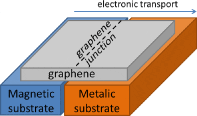 One of the most promising features of graphene is the fact that its properties can be relatively easily tuned by external factors, like for example specific substrates. Moreover, if a single graphene flake spans over two different substrates, the two parts of the flake have different properties and in consequence a junction forms within graphene. Through the analysis of electronic transport the authors show that a special type of anisotropic magnetoresistance can be observed in such systems.
One of the most promising features of graphene is the fact that its properties can be relatively easily tuned by external factors, like for example specific substrates. Moreover, if a single graphene flake spans over two different substrates, the two parts of the flake have different properties and in consequence a junction forms within graphene. Through the analysis of electronic transport the authors show that a special type of anisotropic magnetoresistance can be observed in such systems.
Phys. Status Solidi RRL (2013) DOI 10.1002/pssr.201308052
In-situ series connection of an amorphous silicon photovoltaic tandem module [Rapid Research Letter · rrl solar]
Ahmed Garamoun, Rainer Merz, Shinsuke Miyajima, and Markus B. Schubert
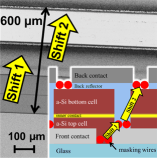 This Letter presents, for the first time, the in-situ series connection of thin film tandem solar cells into a photovoltaic module by sequential local shading of the deposition processes. A module comprising of five amorphous silicon tandem cells with a total area of 12.5 cm2 exhibits a fill factor FFm > 72% and a total area efficiency of ηm = 6.2%.
This Letter presents, for the first time, the in-situ series connection of thin film tandem solar cells into a photovoltaic module by sequential local shading of the deposition processes. A module comprising of five amorphous silicon tandem cells with a total area of 12.5 cm2 exhibits a fill factor FFm > 72% and a total area efficiency of ηm = 6.2%.
Phys. Status Solidi RRL (2013) DOI 10.1002/pssr.201308016
Strained graphene as a local probe for plasmon-enhanced Raman scattering by gold nanostructures [Rapid Research Letter]
Sebastian Heeg, Antonios Oikonomou, Roberto Fernandez Garcia, Stefan A. Maier, Aravind Vijayaraghavan, and Stephanie Reich
 In this Letter, the authors establish the general use of strained graphene as local probes for plasmonic nanostructures (and vice versa) as seen by surface-enhanced Raman spectroscopy. Structures with plasmonic cavities, where enhanced light fields are compressed into sub-wavelength volumes, are particularly suitable to be characterized by this approach. A resolution well below the diffraction limit is achieved.
In this Letter, the authors establish the general use of strained graphene as local probes for plasmonic nanostructures (and vice versa) as seen by surface-enhanced Raman spectroscopy. Structures with plasmonic cavities, where enhanced light fields are compressed into sub-wavelength volumes, are particularly suitable to be characterized by this approach. A resolution well below the diffraction limit is achieved.
Phys. Status Solidi RRL (2013) DOI 10.1002∕pssr.201308145
Influence of inorganic nanoparticles on the glass transitions of polyurea elastomers [Original Paper]
M. Reinecker, A. Fuith, V. Soprunyuk, A. Sánchez-Ferrer, A. Mrzel, R. Torre, and W. Schranz
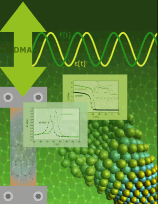 The properties of polymers can be significantly changed by incorporating nanoparticles, which yields a great potential for applications. Reinecker et al. use nanocomposites of new polyurea elastomers filled with 0.1, 0.5 and 1 wt% MoS2 nanotubes. Using dynamic mechanical analysis (DMA) measurements the authors show that the glass transition temperatures Tg of the nanocomposites are increased by small amounts of inorganic nanotubes. In line with results from computer simulations of polymer melts with nanoscopic particles, they explain the observed shift of Tg to be due to a gradual slowing down of polymer chain dynamics in the proximity of nanotubes.
The properties of polymers can be significantly changed by incorporating nanoparticles, which yields a great potential for applications. Reinecker et al. use nanocomposites of new polyurea elastomers filled with 0.1, 0.5 and 1 wt% MoS2 nanotubes. Using dynamic mechanical analysis (DMA) measurements the authors show that the glass transition temperatures Tg of the nanocomposites are increased by small amounts of inorganic nanotubes. In line with results from computer simulations of polymer melts with nanoscopic particles, they explain the observed shift of Tg to be due to a gradual slowing down of polymer chain dynamics in the proximity of nanotubes.
Phys. Status Solidi A (2013) DOI 10.1002/pssa.201329317
Study of atomic layer deposited ZrO2 and ZrO2/TiO2 films for resistive switching application [Original Paper]
I. Kärkkänen, A. Shkabko, M. Heikkilä, J. Niinistö, M. Ritala, M. Leskelä, S. Hoffmann-Eifert, and R. Waser
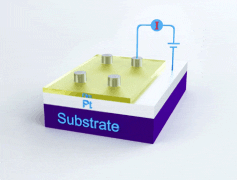 Thin ZrO2 films and ZrO2/TiO2 bilayers grown by atomic layer deposition (ALD) are integrated into metal–oxide–metal structures for investigation of resistive switching properties. The films have different microstructure depending on the used ALD oxygen source and stacking sequence for the bilayers. Pt/ZrO2/Ti/Pt devices show unipolar resistive switching for oxide thicknesses of 11–18 nm. The devices with O3 grown ZrO2 show higher yield in comparison to the ones with H2O processed oxide. The switching polarity of the cells depends on the thickness of the Ti electrode layer and the formation of ZrO2/TiO2 bilayers results in changes in the resistive switching depending on the stacking sequence.
Thin ZrO2 films and ZrO2/TiO2 bilayers grown by atomic layer deposition (ALD) are integrated into metal–oxide–metal structures for investigation of resistive switching properties. The films have different microstructure depending on the used ALD oxygen source and stacking sequence for the bilayers. Pt/ZrO2/Ti/Pt devices show unipolar resistive switching for oxide thicknesses of 11–18 nm. The devices with O3 grown ZrO2 show higher yield in comparison to the ones with H2O processed oxide. The switching polarity of the cells depends on the thickness of the Ti electrode layer and the formation of ZrO2/TiO2 bilayers results in changes in the resistive switching depending on the stacking sequence.
Phys. Status Solidi A (2013) DOI 10.1002/pssa.201330034
Magnetic force microscopy study of shape engineered FEBID iron nanostructures [Original Paper]
Marco Gavagnin, Heinz D. Wanzenboeck, Domagoj Belic, Mostafa M. Shawrav, Anders Persson, Klas Gunnarsson, Peter Svedlindh, and Emmerich Bertagnolli
 The capability to control matter down to the nanoscale in combination with the novel magnetic properties of nanomaterials have attracted increasing attention in the last few decades. Many efforts have been devoted to the characterization of magnetic nanoelements. In this study Fe-based nanostructures have been synthesized on Si(100) by focused electron beam induced deposition (FEBID) utilizing iron pentacarbonyl as precursor. The so obtained nanostructures exhibit a remarkably high iron content, expected to give rise to a ferromagnetic behaviour. For that reason, magnetic force microscopy (MFM) analyses were performed on the obtained FEBID Fe nanostructures. Moreover, simulations have been executed to study the influence of the geometry on the magnetic properties of iron single-domain nanowires.
The capability to control matter down to the nanoscale in combination with the novel magnetic properties of nanomaterials have attracted increasing attention in the last few decades. Many efforts have been devoted to the characterization of magnetic nanoelements. In this study Fe-based nanostructures have been synthesized on Si(100) by focused electron beam induced deposition (FEBID) utilizing iron pentacarbonyl as precursor. The so obtained nanostructures exhibit a remarkably high iron content, expected to give rise to a ferromagnetic behaviour. For that reason, magnetic force microscopy (MFM) analyses were performed on the obtained FEBID Fe nanostructures. Moreover, simulations have been executed to study the influence of the geometry on the magnetic properties of iron single-domain nanowires.
Phys. Status Solidi A (2013) DOI 10.1002∕pssa.201330114
Reservoir model for two-dimensional electron gases in quantizing magnetic fields: a review [Review Article]
W. Zawadzki, A. Raymond, and M. Kubisa
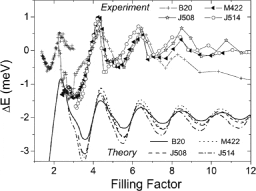 When the quantum Hall effect was discovered, there appeared a natural need to explain the exact values of the observed Hall plateaus. Among other explanations, a reservoir model was put forward in which the electron density oscillates between two-dimensional electron gas (2DEG) and a reservoir. In their Review Article, Zawadzki et al. collect and discuss publications indicating the presence of reservoirs in various experiments on 2DEGs. As shown in the figure, a good theoretical description is obtained with the use of the reservoir model for the oscillatory parts of magneto-photoluminescence energies typically observed on many GaAs/GaAlAs heterostructures.
When the quantum Hall effect was discovered, there appeared a natural need to explain the exact values of the observed Hall plateaus. Among other explanations, a reservoir model was put forward in which the electron density oscillates between two-dimensional electron gas (2DEG) and a reservoir. In their Review Article, Zawadzki et al. collect and discuss publications indicating the presence of reservoirs in various experiments on 2DEGs. As shown in the figure, a good theoretical description is obtained with the use of the reservoir model for the oscillatory parts of magneto-photoluminescence energies typically observed on many GaAs/GaAlAs heterostructures.
Phys. Status Solidi B (2013) DOI 10.1002/pssb.201349251
Systematic chemical functionalization of hybrid molecule–surface interfaces [Feature Article]
V. Caciuc, M. C. Lennartz, N. Atodiresei, S. Tsukamoto, S. Karthäuser, and S. Blügel
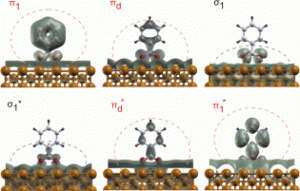 Caciuc et al. briefly summarize their experimental and theoretical results obtained for several carboxylate molecules chemisorbed on the Cu(110) surface with the aim to investigate their potential use in molecular electronic devices. Although the organic molecules are chemisorbed, the authors devised concepts like experimental HOMO–LUMO gap which proved to be useful when comparing the experimental dI /dV spectra with the calculated LDOS. A careful comparison of the dI /dV features with the theoretical LDOS enabled to identify the σ or π character of the hybrid molecule–surface electronic states. Caciuc et al. theoretically predicted and experimentally proved that the electronic structure of a carboxylate–Cu(110) system can be specifically tuned by a chemical functionalization process.
Caciuc et al. briefly summarize their experimental and theoretical results obtained for several carboxylate molecules chemisorbed on the Cu(110) surface with the aim to investigate their potential use in molecular electronic devices. Although the organic molecules are chemisorbed, the authors devised concepts like experimental HOMO–LUMO gap which proved to be useful when comparing the experimental dI /dV spectra with the calculated LDOS. A careful comparison of the dI /dV features with the theoretical LDOS enabled to identify the σ or π character of the hybrid molecule–surface electronic states. Caciuc et al. theoretically predicted and experimentally proved that the electronic structure of a carboxylate–Cu(110) system can be specifically tuned by a chemical functionalization process.
Phys. Status Solidi B (2013) DOI 10.1002/pssb.201349076
Doping of bi-layer graphene by gradually polarizing a ferroelectric polymer [Invited Article]
Martin Kalbac, Jing Kong, and Mildred S. Dresselhaus
 Previous reports on the electrochemical doping of graphene left many open questions; in particular how the electrolyte anions interact with graphene or whether the electrolyte ions penetrate into graphene layers during the doping. To answer these questions Kalbac et al. probed the Raman spectra of two-layer graphene (2-LG), where one graphene layer was of natural 12C isotope composition and the second graphene layer was labeled by the 13C isotope. The authors studied the 2-LG both in its neutral and doped states, which were realized using a polarization of a ferroelectric polymer, and they analyzed the changes in Raman intensity and frequency of the G and G’ modes during electrochemical charging.
Previous reports on the electrochemical doping of graphene left many open questions; in particular how the electrolyte anions interact with graphene or whether the electrolyte ions penetrate into graphene layers during the doping. To answer these questions Kalbac et al. probed the Raman spectra of two-layer graphene (2-LG), where one graphene layer was of natural 12C isotope composition and the second graphene layer was labeled by the 13C isotope. The authors studied the 2-LG both in its neutral and doped states, which were realized using a polarization of a ferroelectric polymer, and they analyzed the changes in Raman intensity and frequency of the G and G’ modes during electrochemical charging.
Phys. Status Solidi B (2013) DOI 10.1002∕pssb.201300053
















